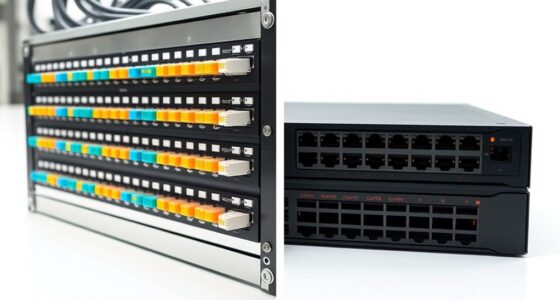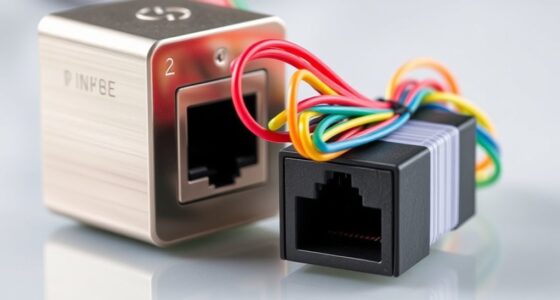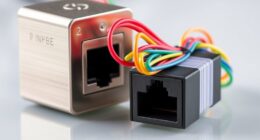Understanding how ARP and DNS work can help you keep your network running smoothly. These protocols are essential for device communication and accessing online resources quickly and reliably. Without them, your network could face delays or failures that disrupt everyday tasks. But how exactly do they support your digital environment? Exploring their roles reveals the key to maintaining a fast, connected, and efficient network.
Key Takeaways
- ARP resolves IP addresses to MAC addresses, enabling local device communication within a subnet.
- DNS translates human-readable domain names into IP addresses for easy resource access.
- ARP maintains a cache to quickly find MAC addresses, reducing network delays.
- DNS caches records and uses hierarchy to efficiently resolve domain names into IPs.
- Both protocols ensure seamless, efficient communication and troubleshooting within a network.

Understanding how ARP and DNS work is essential for managing and troubleshooting your network effectively. These protocols are the backbone of how devices communicate and identify each other within your network and beyond. When you try to access a website or connect to another device, your computer needs to translate human-friendly names into machine-readable IP addresses. This process involves IP Address Resolution, which is where ARP and DNS come into play.
ARP, or Address Resolution Protocol, is responsible for IP Address Resolution on your local network. When your device wants to communicate with another device within the same subnet, it first checks its ARP cache to see if it already knows the MAC (Media Access Control) address associated with the target IP address. If it doesn’t, it broadcasts an ARP request to ask, “Who has this IP address?” When the device with that IP responds with its MAC address, your device updates its ARP table and can now send packets directly to the correct hardware address. This process is swift and transparent, enabling devices to find each other quickly on the local network without manual intervention. Additionally, efficient ARP resolution is vital for maintaining network speed and reducing latency.
ARP resolves IP addresses to MAC addresses within your local network efficiently and transparently.
On the other hand, DNS (Domain Name System) handles Network Name Lookup for devices across different networks. When you type a URL into your browser, your device doesn’t understand the domain name directly; it needs to resolve that name into an IP address. Your device contacts a DNS server, which acts like a phone book, translating human-friendly domain names into the IP addresses computers need to locate each other on the internet. This process involves querying DNS records, and if the DNS server has the information cached, it responds quickly. If not, it forwards the request through a hierarchy of DNS servers until it finds the correct IP address. Once obtained, your device can establish a connection, ensuring seamless access to websites, services, and resources.
Both ARP and DNS are critical for your network’s efficiency and stability. ARP keeps local communications fast and accurate by resolving IP addresses to MAC addresses, while DNS ensures that you can reach websites and services using easy-to-remember domain names instead of numeric IPs. When issues arise—like not being able to load a website or devices not communicating—you often troubleshoot these protocols first. Problems with ARP can cause devices to lose contact within the network, while DNS issues can prevent domain names from resolving, making websites inaccessible. Understanding these processes helps you identify where the problem lies and fix it swiftly, keeping your network running smoothly. Moreover, understanding the role of protocols like ARP and DNS is essential for optimizing network performance and security.
Frequently Asked Questions
How Do ARP and DNS Handle Network Security Concerns?
You’re protected from threats like ARP spoofing and DNS hijacking by implementing security measures such as static ARP entries and DNSSEC. Static ARP entries prevent attackers from redirecting traffic, while DNSSEC authenticates DNS responses, reducing hijacking risks. Regularly updating firmware, using secure protocols, and monitoring network traffic also help you detect suspicious activity, keeping your network safer against these common vulnerabilities.
Can ARP or DNS Be Exploited for Cyberattacks?
Yes, ARP and DNS can be exploited for cyberattacks. You might have heard of ARP spoofing, where attackers intercept data by pretending to be another device, and DNS hijacking, which redirects your traffic to malicious sites. These attacks manipulate network protocols, putting your data at risk. To protect yourself, make sure your network employs security measures like encryption and intrusion detection systems to defend against these vulnerabilities.
How Do ARP and DNS Perform in Large-Scale Enterprise Networks?
You’ll find ARP and DNS handle large-scale enterprise networks well, but they face scalability challenges. ARP quickly resolves IP to MAC addresses locally, yet excessive broadcasts can bog down your network. DNS efficiently manages domain queries with protocol optimization, but high query volumes may cause delays. To keep everything running smoothly, you need to optimize these protocols, implement caching, and monitor traffic to prevent overloads and maintain network performance.
What Are Common Troubleshooting Steps for ARP and DNS Issues?
You might find that ARP and DNS issues are caused by incorrect IP addresses or packet filtering blocking essential traffic. To troubleshoot, verify your IP address configurations and clear ARP caches. Check DNS server settings and ensure no firewall rules are filtering DNS or ARP packets. Use tools like ping and nslookup to diagnose connectivity. These steps help you identify and resolve network problems quickly and keep your network running smoothly.
How Do ARP and DNS Evolve With Modern Networking Technologies?
You see ARP and DNS evolving with modern networking technologies through dynamic addressing and protocol optimization. As networks shift toward IPv6, ARP shifts to Neighbor Discovery Protocol for more efficient address resolution. DNS also adapts with DNSSEC for security and DNS over HTTPS for privacy. These updates help you maintain seamless, secure connectivity, ensuring your network remains resilient and efficient amid technological advancements.
Conclusion
Understanding how ARP and DNS work helps you appreciate the backbone of your network’s efficiency. Did you know that over 75% of internet traffic relies on DNS to quickly connect you to websites? By ensuring smooth device discovery and seamless browsing, these protocols keep your digital experience fast and reliable. When they function properly, you enjoy fewer delays and fewer connection issues—making your online life simpler and more enjoyable every day.








